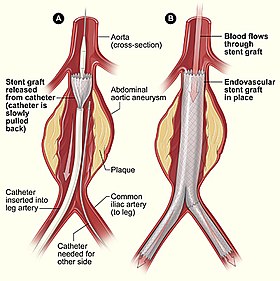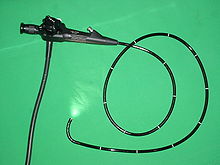Minimally invasive procedure
| Minimally invasive procedure | |
|---|---|
 Endovascular aneurysm repair - example of minimally invasive procedure | |
| MeSH | D019060 |
| eMedicine | 938198 |
Minimally invasive procedures(also known asminimally invasive surgeries) encompasssurgicaltechniques that limit the size of incisions needed, thereby reducingwound healingtime, associated pain, and risk of infection. Surgery by definition is invasive, and many operations requiringincisionsof some size are referred to asopen surgery.Incisions made during open surgery can sometimes leave large wounds that may be painful and take a long time to heal. Advancements inmedical technologieshave enabled the development and regular use of minimally invasive procedures. For example,endovascular aneurysm repair,a minimally invasive surgery, has become the most common method of repairingabdominal aortic aneurysmsin the US as of 2003. The procedure involves much smaller incisions than the correspondingopen surgeryprocedure ofopen aortic surgery.[1]
Interventional radiologistswere the forerunners of minimally invasive procedures. Usingimagingtechniques, radiologists were able to direct interventional instruments through the body by way ofcathetersinstead of the large incisions needed in traditional surgery. As a result, many conditions once requiring surgery can now be treated non-surgically.[2]
Diagnostic techniques that do not involve incisions, puncturing the skin, or the introduction of foreign objects or materials into the body are known asnon-invasive procedures.[3]Several treatment procedures are classified as non-invasive. A major example of a non-invasive alternative treatment to surgery isradiation therapy,also called radiotherapy.[4]
Medical uses[edit]

Minimally invasive procedures were pioneered byinterventional radiologistswho had first introducedangioplastyand the catheter-deliveredstent.Many other minimally invasive procedures have followed where images of all parts of the body can be obtained and used to direct interventional instruments by way ofcatheters(needles and fine tubes), so that many conditions once requiring open surgery can now be treated non-surgically.[2]A minimally invasive procedure typically involves the use ofarthroscopic(for joints and the spine) orlaparoscopicdevices and remote-control manipulation of instruments with indirect observation of the surgical field through anendoscopeor large scale display panel, and is carried out through theskinor through abody cavityor anatomical opening.Interventional radiologynow offers many techniques that avoid the need for surgery.[2]
By use of a minimally invasive procedure, a patient may require only anadhesive bandageon the incision, rather than multiple stitches or staples to close a large incision. This usually results in less infection, a quicker recovery time and shorter hospital stays, or allowoutpatienttreatment.[5]However, the safety and effectiveness of each procedure must be demonstrated withrandomized controlled trials.The term was coined byJohn E. A. Wickhamin 1984, who wrote of it inBritish Medical Journalin 1987.[6]
Specific procedures[edit]

Many medical procedures are called minimally invasive; those that involve small incisions through which an endoscope is inserted, end in the suffix-oscopy,such asendoscopy,laparoscopy,arthroscopy.Other examples of minimally invasive procedures include the use ofhypodermic injection,and air-pressure injection,subdermal implants,refractive surgery,percutaneoussurgery,cryosurgery,microsurgery,keyhole surgery,endovascular surgeryusinginterventional radiology(such asangioplasty),coronary catheterization,permanent placement ofspinalandbrainelectrodes,stereotactic surgery,the Nuss procedure,radioactivity-basedmedical imagingmethods, such asgamma camera,positron emission tomographyandSPECT(single photon emission tomography). Related procedures areimage-guided surgery,androbot-assisted surgery.[7]
Equipment[edit]
Specialmedical equipmentmay be used, such asfiber opticcables, miniaturevideo camerasand specialsurgical instrumentshandled via tubes inserted into the body through small openings in its surface. The images of the interior of the body are transmitted to an externalvideo monitorand the surgeon has the possibility of making adiagnosis,visually identifying internal features and acting surgically on them.[8]
Benefits[edit]
Minimally invasivesurgeryshould have less operativetrauma,othercomplicationsandadverse effectsthan an equivalent open surgery. It may be more or less expensive (for dental implants, a minimally invasive method reduces the cost of installed implants and shortens the implant-prosthetic rehabilitation time with four–six months[9]). Operative time is longer, but hospitalization time is shorter. It causes lesspainandscarring,speeds recovery, and reduces the incidence of post-surgical complications, such asadhesionsandwound rupture.Some studies have comparedheart surgery.[10]
Risks[edit]
Risks and complications of minimally invasive procedures are the same as for any othersurgical operation,among the risks are: death, bleeding,infection,organ injury, andthromboembolic disease.[11]
There may be an increased risk ofhypothermiaand peritoneal trauma due to increased exposure to cold, dry gases duringinsufflation.The use ofsurgical humidificationtherapy, which is the use of heated and humidified CO2for insufflation, may reduce this risk.[12]
Invasive procedures[edit]

Sometimes the use of non-invasive methods is not an option, so that the next level of minimally invasive techniques are looked to. These include the use ofhypodermic injection(using thesyringe), anendoscope,percutaneous surgerywhich involves needle puncture of the skin,laparoscopic surgerycommonly calledkeyhole surgery,acoronary catheter,angioplastyandstereotactic surgery.[citation needed]
Open surgery[edit]
"Open surgery" is any surgical procedure where theincisionmade is enough to allow the surgery to take place. With tissues and structures exposed to the air, the procedure can be performed either with the unaided vision of the surgeon or with the use ofloupesormicroscopes.Some examples of open surgery used are forherniated disccommonly called a "slipped disc", and most types ofcardiac surgeryandneurosurgery.[medical citation needed]
See also[edit]
References[edit]
- ^Sethi RK, Henry AJ, Hevelone ND, Lipsitz SR, Belkin M, Nguyen LL (September 2013)."Impact of hospital market competition on endovascular aneurysm repair adoption and outcomes".J. Vasc. Surg.58(3): 596–606.doi:10.1016/j.jvs.2013.02.014.PMID23684424.
- ^abc"Global Statement Defining Interventional Radiology"(PDF).Journal of Vascular and Interventional Radiology.21(8): 1147–1149. Aug 2010.doi:10.1016/j.jvir.2010.05.006.Archived fromthe original(PDF)on Jul 28, 2011.
- ^Dorland's (2012).Dorland's Illustrated Medical Dictionary(32nd ed.). Elsevier. p. 955.ISBN978-1-4160-6257-8.
- ^Daniel Albert (2012).Dorland's illustrated medical dictionary(32nd ed.). Philadelphia, PA: Saunders/Elsevier. p. 1573.ISBN978-1-4160-6257-8.
- ^"Minimally Invasive Surgical Procedures".MeSH - NCBI.Archivedfrom the original on Sep 29, 2023.
- ^Wickham JE' (1987-12-19)."The new surgery".Br Med J.295(6613): 1581–1582.doi:10.1136/bmj.295.6613.1581.PMC1257475.PMID3121078.
- ^Ahmed K, Khan MS, Vats A, et al. (October 2009)."Current status of robotic assisted pelvic surgery and future developments".International Journal of Surgery.7(5): 431–40.doi:10.1016/j.ijsu.2009.08.008.PMID19735746.
- ^Belzberg, Micah; Mahapatra, Smruti; Perdomo-Pantoja, Alexander; Chavez, Francisco; Morrison, Kyle; Xiong, K. Timothy; Gamo, Nao J.; Restaino, Stephen A.; Thakor, Nitish; Yazdi, Youseph; Iyer, Rajiv; Tyler, Betty; Theodore, Nicholas; Luciano, Mark G.; Brem, Henry; Groves, Mari; Cohen, Alan R.; Manbachi, Amir (2020)."Minimally invasive therapeutic ultrasound: Ultrasound-guided ultrasound ablation in neuro-oncology".Ultrasonics.108(12): 106210.doi:10.1016/j.ultras.2020.106210.PMC8895244.PMID32619834.
- ^Topalo V, Chele N (March 2012)."Minimally invasive method of early dental implant placement in two surgical steps".Revista de chirurgie oro-maxilo-facială și implantologie(in Romanian).3(1): 16–23.ISSN2069-3850.60. Archived fromthe originalon 2016-04-02.Retrieved2012-08-19.(webpage has a translation button)
- ^Kilger E, Weis FC, Goetz AE, et al. (March 2001)."Intensive care after minimally invasive and conventional coronary surgery: a prospective comparison".Intensive Care Medicine.27(3): 534–9.doi:10.1007/s001340000788.PMID11355122.S2CID23157051.
- ^"Minimally Invasive Surgery. Keyhole Surgery information".patient.info.Retrieved2017-05-25.
- ^Peng Y, Zheng M, Ye Q, Chen X, Yu B, Liu B (January 2009). "Heated and humidified CO2prevents hypothermia, peritoneal injury, and intra-abdominal adhesions during prolonged laparoscopic insufflations ".The Journal of Surgical Research.151(1): 40–7.doi:10.1016/j.jss.2008.03.039.PMID18639246.
Further reading[edit]
- "Minimally Invasive Cancer Treatments Highlighted".sciencedaily.November 28, 2005.Retrieved2015-08-03.
- Tachibana K (March 2004). "Emerging technologies in therapeutic ultrasound: thermal ablation to gene delivery".Human Cell.17(1): 7–15.doi:10.1111/j.1749-0774.2004.tb00015.x.PMID15369132.S2CID19482620.
- Kim PE, Singh M (July 2003)."Functional magnetic resonance imaging for brain mapping in neurosurgery".Neurosurgical Focus.15(1): E1.doi:10.3171/foc.2003.15.1.1.PMID15355003.
- Richie RC (2002). "Non-invasive assessment of the risk of coronary heart disease".Journal of Insurance Medicine.34(1): 31–42.PMID15303592.
- Golder W (June 2004). "Magnetic resonance spectroscopy in clinical oncology".Onkologie.27(3): 304–9.doi:10.1159/000077983.PMID15249722.S2CID20644834.
- Cherry SR (February 2004). "In vivo molecular and genomic imaging: new challenges for imaging physics".Physics in Medicine and Biology.49(3): R13–48.doi:10.1088/0031-9155/49/3/R01.PMID15012005.S2CID250810092.
- Lymberis A, Olsson S (2003). "Intelligent biomedical clothing for personal health and disease management: state of the art and future vision".Telemedicine Journal and e-Health.9(4): 379–86.doi:10.1089/153056203772744716.PMID14980096.
- Söling A, Rainov NG (October 2003). "Bioluminescence imaging in vivo - application to cancer research".Expert Opinion on Biological Therapy.3(7): 1163–72.doi:10.1517/14712598.3.7.1163.PMID14519079.S2CID28865110.
- Rohrscheib M, Robinson R, Eaton RP (September 2003). "Non-invasive glucose sensors and improved informatics--the future of diabetes management".Diabetes, Obesity & Metabolism.5(5): 280–4.doi:10.1046/j.1463-1326.2003.00275.x.PMID12940864.S2CID7192060.
- Jacobs AH, Winkeler A, Dittmar C, Hilker R, Heiss WD (2002). "Prospects of molecular imaging in neurology".Journal of Cellular Biochemistry. Supplement.39:98–109.doi:10.1002/jcb.10414.PMID12552609.S2CID8618818.
- Malhi GS, Valenzuela M, Wen W, Sachdev P (February 2002). "Magnetic resonance spectroscopy and its applications in psychiatry".The Australian and New Zealand Journal of Psychiatry.36(1): 31–43.doi:10.1046/j.1440-1614.2002.00992.x.PMID11929436.S2CID15981685.
- Jacobs A, Heiss WD (April 2002). "Towards non-invasive imaging of HSV-1 vector-mediated gene expression by positron emission tomography".Veterinary Microbiology.86(1–2): 27–36.doi:10.1016/S0378-1135(01)00488-6.PMID11888687.
- Leman JA, Morton CA (January 2002). "Photodynamic therapy: applications in dermatology".Expert Opinion on Biological Therapy.2(1): 45–53.doi:10.1517/14712598.2.1.45.PMID11772339.S2CID40893453.
- Richter JE (November 1997). "Ambulatory esophageal pH monitoring".The American Journal of Medicine.103(5A): 130S–134S.doi:10.1016/S0002-9343(97)00338-0.PMID9422638.
External links[edit]
- Minimally invasive heart surgery.Medical Encyclopedia, MedlinePlus.
